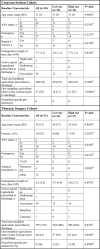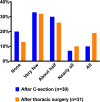Opioid Use and Storage Patterns by Patients after Hospital Discharge following Surgery
- PMID: 26824844
- PMCID: PMC4732746
- DOI: 10.1371/journal.pone.0147972
Opioid Use and Storage Patterns by Patients after Hospital Discharge following Surgery
Abstract
Introduction: Opioid-based analgesic therapy represents a cornerstone of pain management after surgery. The recent rise in opioid sales and opioid overdoses suggests it is important to maximize the safety of opioid prescribing after surgery. Given that patients may live with other family members in the home, safe storage and appropriate disposal of excess opioids after hospital discharge are necessary to prevent unintended secondary exposures. Identifying characteristics of patients who are likely to be prescribed excess opioids after surgery may enable more targeted prescription practices and safety interventions. Our study aimed to elucidate patient-reported opioid use patterns and modes of home storage of opioids among patients discharged home after Cesarean section (C-section) and thoracic surgery. Specifically, we sought to identify characteristics of patients who reported using about half or more versus less of the opioids prescribed to them for use after hospital discharge.
Methods: For this cohort study, we developed a survey on quality of analgesia following hospital discharge, amounts of opioids taken relative to the amount prescribed, reasons for not taking all prescribed medications, and storage and disposal methods for leftover opioids. Adult patients, who had C-section or thoracic surgery at a tertiary academic medical center, were given a web-based self-administered survey after discharge. Descriptive statistics (means and standard deviations, proportions) were used to describe the study sample and survey results. Comparisons between patients who reported taking about half or more versus less of the opioids prescribed to them for use after hospital discharge were made using unpaired t-tests, Mann-Whitney tests, and Chi-square tests as appropriate.
Results: The majority (53%) of respondents after C-section (N = 30) reported taking either no or very few (less than 5) prescribed opioid pills; 83% reported taking half or less; and 17% of women, reported taking all or nearly all (5 or fewer pills left over) of their opioid prescription. In a cohort of patients after thoracic surgery (n = 31) 45% reported taking either no or very few (5 or less) prescribed opioid pills; 71% reported taking half or less; and 29% of patients reported taking all or nearly all (5 or fewer pills left over) of their opioid prescription. In both cohorts, use of opioids while hospitalized was higher in the group reporting using about half or more of prescribed opioids after discharge. Leftover opioids were stored in an unlocked location in 77% and 73% of cases following C-section and thoracic surgery, respectively.
Conclusion: Our findings from surveys in two distinct patient populations at a single academic medical center suggest that current opioid prescribing practices for pain management at hospital discharge following Cesarean section and thoracic surgery may not account for individual patients' analgesic requirements. Excess opioid pills are commonly stored in unsecured locations and represent a potential source for non-medical opioid use and associated morbidity and mortality in patients and their families. Research to develop goal-directed and patient-centered post-discharge opioid prescription practices and encourage opioid safety practices after surgery is needed.
Conflict of interest statement
Figures



References
Publication types
MeSH terms
Substances
Associated data
Grants and funding
LinkOut - more resources
Full Text Sources
Other Literature Sources
Medical

